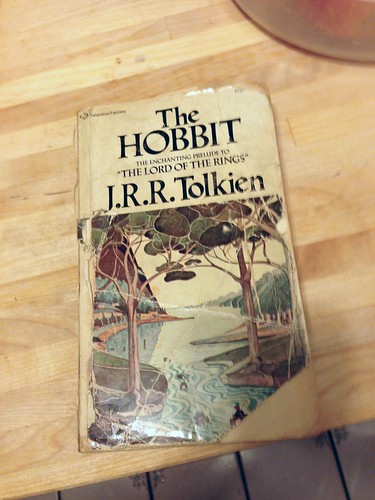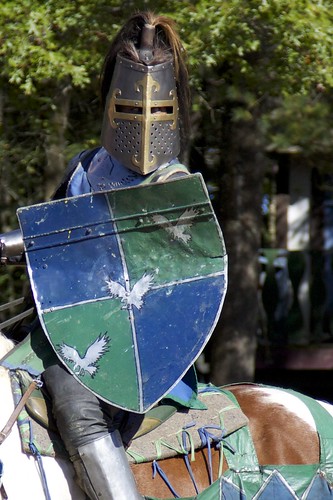 Melanie and I took advantage of having her mom with us and not yet having a newborn baby to go to the movies, something we don’t ever get to do. I think the last movie we saw in a theater was the Star Trek reboot in 2009. So this time, we went to the matinée of The Hobbit in IMAX 3D at the local theater.
Melanie and I took advantage of having her mom with us and not yet having a newborn baby to go to the movies, something we don’t ever get to do. I think the last movie we saw in a theater was the Star Trek reboot in 2009. So this time, we went to the matinée of The Hobbit in IMAX 3D at the local theater.
To put my remarks in perspective, I will point you to the photo accompanying this post. It’s a photo of a 36-year-old copy of The Hobbit. When I was eight, I saw it sitting on my mother’s bedside nighttable and picked it up, thus changing my life from that moment. Over the next two decades I read The Hobbit and The Lord of the Rings several dozen times, as well as The Silmarillion, the 12-volume Histories of Middle Earth, Unfinished Tales, the Children of Hurin, etc. I am a devourer of Tolkien’s literary opus magnus on Middle Earth. Not only that, but the book also launched me on a lifelong love of the genre, which admittedly has resulted in plenty of not-so-good imitators and very few almost-as-good novels.
So when I say I approach this film differently from many movie fans, that’s what I mean. The obvious question is whether I liked the movie. Having heard so many disappointed reviews I was braced for the worst, but I did recognize going in that those who I knew were Tolkien fans like me had given it high marks.
First, I know I sound like an old man, but when did movies get so loud? Right from the first trailer, I actually had to hold one hand over an ear at times. Second, while I enjoyed the IMAX 3D experience, Melanie did not and made me promise for the second and third movies that there would be no 3D. She said it makes it seem blurry to her.
As for the movie itself, I liked it. I thought the addition of the material from appendices was a good move. In a sense the director Peter Jackson isn’t making The Hobbit, per se. He’s making a movie that fills in the gaps in the story of the War of the Ring at the End of the Third Age that the first three movies did not tell. I’m okay with that.
I saw some didn’t like the more playful elements, like the Dwarves throwing the dishes at Bilbo’s home or the Goblin King’s too-humanness or Radagast’s oddities or the three trolls’ vaudevillian act. All those scenes are true to Tolkien’s original story and in fact, in some cases I think Jackson could have gone further. I genuinely missed Bilbo’s tricking the trolls with the different voices, not to mention their names: Tom, Bert, and William. But he also changed the substance of the scene, where the book has Bilbo getting entangled with the trolls because he wants to prove himself as the burglar he was hired to be.
Of course, being a big-budget blockbuster, there has to be plenty of action, a lot more than the book offered. Melanie counted at least six literal cliffhanger scenes (someone actually clinging to a cliff) and a whole lot more pitched battles. I suppose I also accept the presence of Azog the Orc. I can see the filmmaker’s need–where the novelist had none–to have an antagonist to thread throughout the story against our protagonists. As others have pointed out, the book is very episodic and not a continuous story, like The Lord of the Rings. You can tell it was composed as a series of bedtime tales that thread together. Thus Jackson needed something to unite all the episodes across three movies. I think this method will do.
If I were to be a strict adherent to Tolkien, I would be more disturbed by the places that diverged from the book, especially where such divergence didn’t seem necessary for the medium. But that’s not me. I can appreciate the movie on its own terms and as a creative work separate but related to Tolkien’s, a sibling artwork, if you will.
Finally, I’ll leave you with these final thoughts. Every time I saw a sweeping vista or the framing of an iconic place in the story, whether it was Hobbiton or the Misty Mountains or Erebor, I was caught up in the joy of seeing it for real. Of course, I know intellectually that it’s not really Middle Earth, but some location in New Zealand. And yet, it also seems real. As a boy, I lived in Middle Earth in some sense, or it inhabited me. I pored over those books and over every map and companion guide I could get my hands on. I knew every corner of the place. And now here before me in glorious IMAX those places have come to life. In that theater, I felt the old yearning I had as a boy to be there, to go there and back again, if you will. And perhaps it’s The Hobbit’s ability to elicit that fundamental response in me that let’s this fan boy say, I really, really liked this movie.

